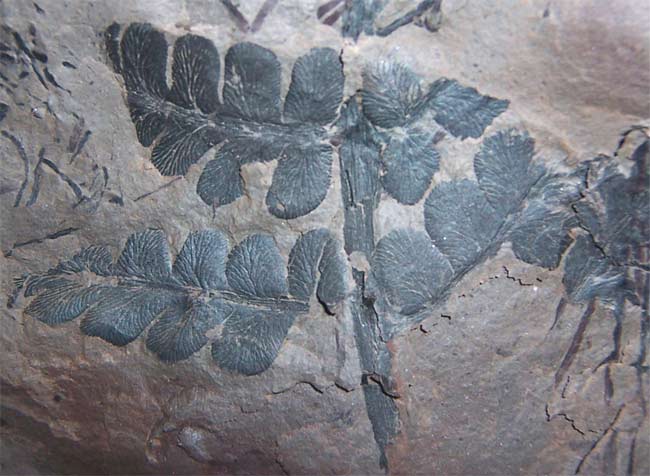Ancient Rainforest Revealed in Coal Mine

Scientists exploring a mine have uncovered a natural Sistine chapel showing not religious paintings, but incredibly well preserved images of sprawling tree trunks and fallen leaves that once breathed life into an ancient rainforest.
Replete with a diverse mix of extinct plants, the 300-million-year-old fossilized forest is revealing clues about the ecology of Earth’s first rainforests. The discovery and details of the forest are published in the May issue of the journal Geology.
“We’re looking at one instance in time over a large area. It’s literally a snapshot in time of a multiple square mile area,” said study team member Scott Elrick of the Illinois State Geological Survey (ISGS).
Forest find
Over millions of years as sediments and plant material pile up, layer upon layer, the resulting bands become time indicators with the newest, youngest layer on the top and the oldest layer at the bottom. Typically geologists peel away a vertical slice of rocky material to look at fossils spanning several time periods.
A coal mine offers a unique view of the past. Instead of a time sequence, illuminated in the layer upon layer of sediments, the roof of an underground mine reveals a large area within one of those sediment layers, or time periods.
Miners in Illinois are used to seeing a few plant fossils strewn along a mine’s ceiling, but as they burrowed farther into this one, the sheer density and area covered by such fossils struck them as phenomenal, Elrick said.
Sign up for the Live Science daily newsletter now
Get the world’s most fascinating discoveries delivered straight to your inbox.
That’s when they called paleobotanist Howard Falcon-Lang from the University of Bristol in the United Kingdom and William DiMichele, a curator of fossil plants at the Smithsonian National Museum of Natural History.
"It was an amazing experience. We drove down the mine in an armored vehicle, until we were a hundred meters below the surface,” Falcon-Lang said. “The fossil forest was rooted on top of the coal seam, so where the coal had been mined away the fossilized forest was visible in the ceiling of the mine.” Forest snapshot
Here’s what the miners and other scientists saw underground: Relatively narrow passageways wind through the “cave,” marked off with stout 100-foot-wide pillars to ensure the roof doesn’t collapse.
“It’s like in some bizarre Roman temple with tons of Corinthian pillars that are 100 feet across and only six feet tall,” Elrick told LiveScience. “As you’re walking down these passageways you see these pillars of coal on either side of you and above you—imagine an artist’s canvas painted a flat grey and that is sort of what the grey shale above the coal looks like.”
The largest ever found, the fossil forest covers an area of about 4 square miles. This ancient assemblage of flora is thought to be one of the first rainforests on Earth, emerging during the Upper Carboniferous, or Pennsylvanian, time period that extended from about 310 million to 290 million years ago.
A reconstruction of the ancient forest showed that like today’s rainforests, it had a layered structure with a mix of plants now extinct: Abundant club mosses stood more than 130-feet high, towering over a sub-canopy of tree ferns and an assortment of shrubs and tree-sized horsetails that looked like giant asparagus.
Flash freeze
The scientists think a major earthquake about 300 million years ago caused the region to drop below sea level where it was buried in mud. They estimate that within a period of months the forest was buried, preserving it “forever.”
“Some of these tree stumps have been covered geologically speaking in a flash,” Elrick said.
Because the spatial layout of the forest has been maintained, the scientists can learn about entire plant communities, not just individual plants.
"This spectacular discovery allows us to track how the species make-up of the forest changed across the landscape, and how that species make-up is affected by subtle differences in the local environment," Falcon-Lang said.
The fossil forest extends along the ceiling of two adjacent mines, the Riola mine and the Vermillion Grove mine, which are located in Vermilion County, just south of Danville, Ill.
- World’s First Tree Reconstructed
- Surprise: Rainforest Grows When It's Dry
- Timeline: The Frightening Future of Earth
Jeanna Bryner is managing editor of Scientific American. Previously she was editor in chief of Live Science and, prior to that, an editor at Scholastic's Science World magazine. Bryner has an English degree from Salisbury University, a master's degree in biogeochemistry and environmental sciences from the University of Maryland and a graduate science journalism degree from New York University. She has worked as a biologist in Florida, where she monitored wetlands and did field surveys for endangered species, including the gorgeous Florida Scrub Jay. She also received an ocean sciences journalism fellowship from the Woods Hole Oceanographic Institution. She is a firm believer that science is for everyone and that just about everything can be viewed through the lens of science.









